Don Lind, astronaut, dies
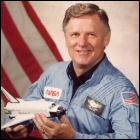 Don Lind, a veteran of the Apollo, Skylab and space shuttle eras at NASA, dies at the age of 92. Born in Midvale, Utah, his service as a U.S. Navy pilot and a degree in nuclear physics brought him to the attention of NASA, and he was a member of the agency’s fifth astronaut class, many of whom went to the moon. Lind was considered for the crew of Apollo 20 until that mission’s cancellation. During the Skylab space station’s tenure, he was assigned to the crew of the Skylab Rescue contingency mission (which ultimately was deemed unnecessary) and then as a potential member of a fourth Skylab crew, whose mission was also cancelled. By the time Lind made his only spaceflight, aboard the shuttle Challenger in 1985, he had been waiting nearly two decades for a flight. He retired from NASA following his flight, and went on to teach at Utah State University.
Don Lind, a veteran of the Apollo, Skylab and space shuttle eras at NASA, dies at the age of 92. Born in Midvale, Utah, his service as a U.S. Navy pilot and a degree in nuclear physics brought him to the attention of NASA, and he was a member of the agency’s fifth astronaut class, many of whom went to the moon. Lind was considered for the crew of Apollo 20 until that mission’s cancellation. During the Skylab space station’s tenure, he was assigned to the crew of the Skylab Rescue contingency mission (which ultimately was deemed unnecessary) and then as a potential member of a fourth Skylab crew, whose mission was also cancelled. By the time Lind made his only spaceflight, aboard the shuttle Challenger in 1985, he had been waiting nearly two decades for a flight. He retired from NASA following his flight, and went on to teach at Utah State University.
Michael Collins, astronaut, dies
 Apollo 11 command module pilot Michael Collins, who remained in the command module Columbia in orbit of the moon while his crewmates, Neil Armstrong and Buzz Aldrin, landed on the moon, dies at the age of 90 after battling cancer. Upon returning to Earth, Collins opted to retire from NASA and found work within the United States government, leading to his becoming the first director of the National Air & Space Museum, a facility which had yet to open at the time he took charge of it. Collins wrote a memoir, Carrying The Fire, in 1974, one of the earliest astronaut memoirs (and the first from a member of the crew charged with making the first lunar landing). Prior to Apollo 11, he had flown with John Young aboard Gemini 10, and prior to that had distinguished careers as both a fighter pilot and a test pilot. He applied for the second group of NASA astronauts, but didn’t make the cut until NASA was recruiting its third class.
Apollo 11 command module pilot Michael Collins, who remained in the command module Columbia in orbit of the moon while his crewmates, Neil Armstrong and Buzz Aldrin, landed on the moon, dies at the age of 90 after battling cancer. Upon returning to Earth, Collins opted to retire from NASA and found work within the United States government, leading to his becoming the first director of the National Air & Space Museum, a facility which had yet to open at the time he took charge of it. Collins wrote a memoir, Carrying The Fire, in 1974, one of the earliest astronaut memoirs (and the first from a member of the crew charged with making the first lunar landing). Prior to Apollo 11, he had flown with John Young aboard Gemini 10, and prior to that had distinguished careers as both a fighter pilot and a test pilot. He applied for the second group of NASA astronauts, but didn’t make the cut until NASA was recruiting its third class.
Al Worden, astronaut, dies
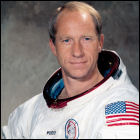 Apollo 15 astronaut Al Worden dies at the age of 88. As the mission’s command module pilot, he was the only member of Apollo 15’s crew to not walk on the moon, though he does still hold the distinction of performing the furthest spacewalk from Earth, when he retrieved film cannisters from the body of the service module, requiring him to suit up and venture outside the vehicle while it was roughly halfway on its journey from the moon back to Earth. With the other members of the crew, he was embroiled in a seemingly minor scandal involving space-flown postal covers that turned out to almost be a career-ender once the astronauts were back on Earth; he made the jump to NASA’s Ames Research Center rather than returning to the Air Force, where he had been a past instructor at the Aerospace Research Pilot School, reporting directly to Colonel Chuck Yeager. After retiring from NASA, he made an unsuccessful run for Congress in 1982, and continued promoting the space program and science education.
Apollo 15 astronaut Al Worden dies at the age of 88. As the mission’s command module pilot, he was the only member of Apollo 15’s crew to not walk on the moon, though he does still hold the distinction of performing the furthest spacewalk from Earth, when he retrieved film cannisters from the body of the service module, requiring him to suit up and venture outside the vehicle while it was roughly halfway on its journey from the moon back to Earth. With the other members of the crew, he was embroiled in a seemingly minor scandal involving space-flown postal covers that turned out to almost be a career-ender once the astronauts were back on Earth; he made the jump to NASA’s Ames Research Center rather than returning to the Air Force, where he had been a past instructor at the Aerospace Research Pilot School, reporting directly to Colonel Chuck Yeager. After retiring from NASA, he made an unsuccessful run for Congress in 1982, and continued promoting the space program and science education.
Richard Gordon, astronaut, dies
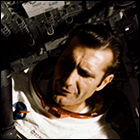 Gemini and Apollo astronaut Richard “Dick” Gordon dies at the age of 88. A veteran of the record-setting Gemini 11 mission (during which he undertook a spacewalk at the unprecedented altitude of 850 miles above Earth’s surface) and the Apollo 12 mission (during which he manned the command module Yankee Clipper while crewmates Pete Conrad and Alan Bean walked on the moon), Gordon was a naval aviator who eventually graduated to test pilot duties, eventually specializing in the F4H Phantom II fighter and teaching other pilots how to fly it. After his Apollo flight and retirement from NASA, Gordon kept working in the technology and engineering industries, but also diversified, becoming Executive VP of the New Orleans Saints football team.
Gemini and Apollo astronaut Richard “Dick” Gordon dies at the age of 88. A veteran of the record-setting Gemini 11 mission (during which he undertook a spacewalk at the unprecedented altitude of 850 miles above Earth’s surface) and the Apollo 12 mission (during which he manned the command module Yankee Clipper while crewmates Pete Conrad and Alan Bean walked on the moon), Gordon was a naval aviator who eventually graduated to test pilot duties, eventually specializing in the F4H Phantom II fighter and teaching other pilots how to fly it. After his Apollo flight and retirement from NASA, Gordon kept working in the technology and engineering industries, but also diversified, becoming Executive VP of the New Orleans Saints football team.
Gene Cernan, Apollo 17 astronaut, dies
 Apollo 17 Commander Eugene Cernan, the last human to leave the surface of the moon in the 20th century, dies at the age of 82. One of the members of NASA’s second astronaut class, recruited in 1963 to take part in the Gemini program, Cernan first flew into space aboard Gemini 9 in 1966, a mission in which he became the second American spacewalker, though his assigned tasks outside the Gemini spacecraft proved to be dangerously exhausting. His second flight, as the lunar module pilot for Apollo 10, saw him flying a lunar lander to within miles of the moon’s surface in May 1969, a dress rehearsal for the upcoming Apollo 11 mission. He commanded the final Apollo moon landing mission, Apollo 17, in December 1972, where he earned the title of “last man on the moon” by being the last astronaut to leave the lunar surface to re-enter the Apollo 17 lander. He later wrote an autobiography about his spaceflight experiences, and was frequently outspoken about his disappointment that no one walked on the moon again in his lifetime.
Apollo 17 Commander Eugene Cernan, the last human to leave the surface of the moon in the 20th century, dies at the age of 82. One of the members of NASA’s second astronaut class, recruited in 1963 to take part in the Gemini program, Cernan first flew into space aboard Gemini 9 in 1966, a mission in which he became the second American spacewalker, though his assigned tasks outside the Gemini spacecraft proved to be dangerously exhausting. His second flight, as the lunar module pilot for Apollo 10, saw him flying a lunar lander to within miles of the moon’s surface in May 1969, a dress rehearsal for the upcoming Apollo 11 mission. He commanded the final Apollo moon landing mission, Apollo 17, in December 1972, where he earned the title of “last man on the moon” by being the last astronaut to leave the lunar surface to re-enter the Apollo 17 lander. He later wrote an autobiography about his spaceflight experiences, and was frequently outspoken about his disappointment that no one walked on the moon again in his lifetime.
Ed Mitchell, Apollo 14 astronaut, dies
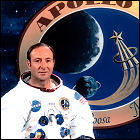 On the eve of the 45th anniversary of the Apollo 14 moon landing, astronaut Edgar “Ed” Mitchell dies at the age of 85. The sixth human being to set foot on the moon, Mitchell accompanied Alan Shepard to the lunar surface aboard the Apollo 14 lander. Following his visit to the moon, Mitchell had become interested in researching human consciousness and extra-sensory perception, but later surrounded himself with controversy by claiming that he was certain that UFOs had visited Earth.
On the eve of the 45th anniversary of the Apollo 14 moon landing, astronaut Edgar “Ed” Mitchell dies at the age of 85. The sixth human being to set foot on the moon, Mitchell accompanied Alan Shepard to the lunar surface aboard the Apollo 14 lander. Following his visit to the moon, Mitchell had become interested in researching human consciousness and extra-sensory perception, but later surrounded himself with controversy by claiming that he was certain that UFOs had visited Earth.
Saturn V F-1 engine revived for tests
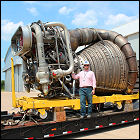 NASA recalls an actual 1960s F-1 engine – of which clusters of five once launched the mighty Saturn V rockets during the Apollo lunar program – from the Smithsonian for refurbishment and, for the first time in over four decades, re-firing on a test stand at Marshall Space Flight Center in Alabama. NASA engineers examine the properties of the F-1 engine – whose performance still outrates the engines used during the Space Shuttle program – to learn how to improve the J-2X engines planned for use in the first stage of the SLS (Space Launch System) booster that will launch Orion vehicles.
NASA recalls an actual 1960s F-1 engine – of which clusters of five once launched the mighty Saturn V rockets during the Apollo lunar program – from the Smithsonian for refurbishment and, for the first time in over four decades, re-firing on a test stand at Marshall Space Flight Center in Alabama. NASA engineers examine the properties of the F-1 engine – whose performance still outrates the engines used during the Space Shuttle program – to learn how to improve the J-2X engines planned for use in the first stage of the SLS (Space Launch System) booster that will launch Orion vehicles.
The longest-serving astronaut retires
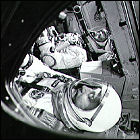 A veteran of the Gemini, Apollo and shuttle programs, 74-year-old astronaut John Young retires from NASA, capping off a 42-year career with the space agency. Young joined NASA in 1962 after hearing President Kennedy’s historic directive to launch a manned mission to the moon, and only three years later Young flew with Mercury veteran Gus Grissom on Gemini 3, the first manned two-person NASA mission. Young commanded Gemini 10 in 1966, was the command module pilot for the moon-orbiting Apollo 10 mission, and in 1972, Young commanded Apollo 16, landing in the moon’s mountainous Descartes region. Young commanded the first space shuttle mission, the maiden flight of Columbia in 1981, and commanded the ninth shuttle flight in 1983. Young had also served as the Chief Astronaut, determining crew assignments and making personnel decisions. In the wake of the Challenger disaster in 1986, Young became one of NASA’s most outspoken critics, and was reassigned to the position of special assistant for engineering, operations and safety – a move he regarded as a political one.
A veteran of the Gemini, Apollo and shuttle programs, 74-year-old astronaut John Young retires from NASA, capping off a 42-year career with the space agency. Young joined NASA in 1962 after hearing President Kennedy’s historic directive to launch a manned mission to the moon, and only three years later Young flew with Mercury veteran Gus Grissom on Gemini 3, the first manned two-person NASA mission. Young commanded Gemini 10 in 1966, was the command module pilot for the moon-orbiting Apollo 10 mission, and in 1972, Young commanded Apollo 16, landing in the moon’s mountainous Descartes region. Young commanded the first space shuttle mission, the maiden flight of Columbia in 1981, and commanded the ninth shuttle flight in 1983. Young had also served as the Chief Astronaut, determining crew assignments and making personnel decisions. In the wake of the Challenger disaster in 1986, Young became one of NASA’s most outspoken critics, and was reassigned to the position of special assistant for engineering, operations and safety – a move he regarded as a political one.
Light This Candle: The Life & Times of Alan Shepard
 Crown Books posthumously publishes Neal Thompson’s non-fictional biography, “Light This Candle: The Life & Times of Alan Shepard“, chronicling the life and career of Alan B. Shepard, the first of the Mercury astronauts to reach space, and the only veteran of the Mercury program to later walk on the moon despite medical issues that nearly ended his spaceflight career.
Crown Books posthumously publishes Neal Thompson’s non-fictional biography, “Light This Candle: The Life & Times of Alan Shepard“, chronicling the life and career of Alan B. Shepard, the first of the Mercury astronauts to reach space, and the only veteran of the Mercury program to later walk on the moon despite medical issues that nearly ended his spaceflight career.
We Have Capture: Tom Stafford and the Space Race
 Smithsonian Books publishes General Thomas Stafford’s non-fictional memoir of his time in NASA, “We Have Capture: Tom Stafford and the Space Race“, co-written with Michael Cassutt. The book details Stafford’s involvement in several NASA missions, from the Gemini program through the high-profile flights of Apollo 10 to the moon and the international Apollo-Soyuz Test Project mission.
Smithsonian Books publishes General Thomas Stafford’s non-fictional memoir of his time in NASA, “We Have Capture: Tom Stafford and the Space Race“, co-written with Michael Cassutt. The book details Stafford’s involvement in several NASA missions, from the Gemini program through the high-profile flights of Apollo 10 to the moon and the international Apollo-Soyuz Test Project mission.
Apollo rides again?
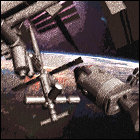 Last flown in the 1975 Apollo-Soyuz mission, the Apollo command/service module is – briefly – given strong consideration by NASA to serve as a “lifeboat” for the crew of the International Space Station, even to the point of conducting a study about un-mothballing the surviving unused Apollo hardware sitting in museums around the world. Part of the reason for this unusual study is that NASA’s budget has run out for finding a workable solution to keeping a “lifeboat” available to station astronauts in the anticipated long gap before the Space Shuttle’s return to service. Ultimately, even the seemingly unthinkable return of Apollo is nixed, since at least a Saturn IB booster would need to be similarly refitted – at huge expense – to lift a 30-year-old Apollo capsule into space.
Last flown in the 1975 Apollo-Soyuz mission, the Apollo command/service module is – briefly – given strong consideration by NASA to serve as a “lifeboat” for the crew of the International Space Station, even to the point of conducting a study about un-mothballing the surviving unused Apollo hardware sitting in museums around the world. Part of the reason for this unusual study is that NASA’s budget has run out for finding a workable solution to keeping a “lifeboat” available to station astronauts in the anticipated long gap before the Space Shuttle’s return to service. Ultimately, even the seemingly unthinkable return of Apollo is nixed, since at least a Saturn IB booster would need to be similarly refitted – at huge expense – to lift a 30-year-old Apollo capsule into space.
One giant can of whoop-ass for mankind
 As Apollo 11 astronaut Buzz Aldrin leaves a speaking engagement in Beverly Hills, a self-proclaimed skeptic accosts him, demanding that the astronaut swear on the Bible that he actually went to the moon. With a Japanese news crew’s cameras rolling, Aldrin proceeds to punch the man in the face. The heckler and self-proclaimed “ambush journalist” tries to file assault charges, though police decide in Aldrin’s favor – especially since this is the third time the man has ambushed Aldrin with his theory that all of the Apollo flights to the moon were hoaxes.
As Apollo 11 astronaut Buzz Aldrin leaves a speaking engagement in Beverly Hills, a self-proclaimed skeptic accosts him, demanding that the astronaut swear on the Bible that he actually went to the moon. With a Japanese news crew’s cameras rolling, Aldrin proceeds to punch the man in the face. The heckler and self-proclaimed “ambush journalist” tries to file assault charges, though police decide in Aldrin’s favor – especially since this is the third time the man has ambushed Aldrin with his theory that all of the Apollo flights to the moon were hoaxes.
Pete Conrad, astronaut, dies
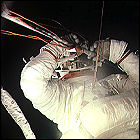 Pete Conrad, the Apollo 12 commander who was the third human to walk on the moon, dies at the age of 69 from injuries suffered in a motorcycle accident. Conrad went to the moon in November 1969, and flew two earlier Gemini missions, one of which was a new human endurance record at the time. Conrad later went on to set a new record for time spent by a human in space (28 days, unprecedented at the time) in 1973 as a member of the first Skylab crew. Conrad and fellow Skylab astronaut Joseph Kerwin performed an extended and very hazardous spacewalk to repair the station, which had been heavily damaged during launch a few weeks before its crew arrived.
Pete Conrad, the Apollo 12 commander who was the third human to walk on the moon, dies at the age of 69 from injuries suffered in a motorcycle accident. Conrad went to the moon in November 1969, and flew two earlier Gemini missions, one of which was a new human endurance record at the time. Conrad later went on to set a new record for time spent by a human in space (28 days, unprecedented at the time) in 1973 as a member of the first Skylab crew. Conrad and fellow Skylab astronaut Joseph Kerwin performed an extended and very hazardous spacewalk to repair the station, which had been heavily damaged during launch a few weeks before its crew arrived.
Deke! U.S. Manned Space From Mercury to the Shuttle
 Forge Books posthumously publishes astronaut Deke Slayton’s non-fictional memoir of his time in NASA, “Deke! U.S. Manned Space From Mercury to the Shuttle“, co-written with Michael Cassutt. The book details Slayton’s selection to the Mercury ground and his subsequent medical grounding, his time in charge of NASA’s astronaut office, and his eventual flight aboard the international Apollo-Soyuz Test Project mission.
Forge Books posthumously publishes astronaut Deke Slayton’s non-fictional memoir of his time in NASA, “Deke! U.S. Manned Space From Mercury to the Shuttle“, co-written with Michael Cassutt. The book details Slayton’s selection to the Mercury ground and his subsequent medical grounding, his time in charge of NASA’s astronaut office, and his eventual flight aboard the international Apollo-Soyuz Test Project mission.
Apollo’s final descent danger
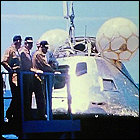 The “age of Apollo” comes to an unbreathable end in an incident during the return of the final Apollo spacecraft. Returning from their successful Apollo-Soyuz Test Project flight, astronauts Thomas Stafford, Deke Slayton and Vance Brand are exposed to fumes from their vehicle’s own reaction control thrusters, thanks to the thrusters firing after the capsule’s air vents open during descent toward the Pacific Ocean. Brand reportedly passes out momentarily due to the toxic fumes. All three astronauts are hospitalized for two weeks in Hawaii.
The “age of Apollo” comes to an unbreathable end in an incident during the return of the final Apollo spacecraft. Returning from their successful Apollo-Soyuz Test Project flight, astronauts Thomas Stafford, Deke Slayton and Vance Brand are exposed to fumes from their vehicle’s own reaction control thrusters, thanks to the thrusters firing after the capsule’s air vents open during descent toward the Pacific Ocean. Brand reportedly passes out momentarily due to the toxic fumes. All three astronauts are hospitalized for two weeks in Hawaii.
Apollo-Soyuz and Soyuz 19
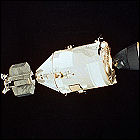 The final launch of an Apollo spacecraft takes place as the last Saturn rocket carries the American component of the Apollo-Soyuz Test Project into orbit. A cooperative international mission intended to see the Apollo capsule dock with a Soviet-launched Soyuz, the ASTP will be the last Apollo flight as the push toward the reusable Space Shuttle takes over NASA’s resources and planning. Aboard the Apollo command/service module are Commander Thomas Stafford, command module pilot Vance Brand, and docking module pilot Deke Slayton, the last of the seven original Mercury astronauts to reach space (heart conditions have prevented him from taking part in a mission until now). Soyuz 19, carrying cosmonauts Alexei Leonov and Valery Kubasov, lifts off a few hours earlier.
The final launch of an Apollo spacecraft takes place as the last Saturn rocket carries the American component of the Apollo-Soyuz Test Project into orbit. A cooperative international mission intended to see the Apollo capsule dock with a Soviet-launched Soyuz, the ASTP will be the last Apollo flight as the push toward the reusable Space Shuttle takes over NASA’s resources and planning. Aboard the Apollo command/service module are Commander Thomas Stafford, command module pilot Vance Brand, and docking module pilot Deke Slayton, the last of the seven original Mercury astronauts to reach space (heart conditions have prevented him from taking part in a mission until now). Soyuz 19, carrying cosmonauts Alexei Leonov and Valery Kubasov, lifts off a few hours earlier.
Skylab 4
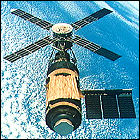 The third and final crew of the first American space station, Skylab 4, lifts off for an 84-day stay. The crew’s tasks include medical and biological experiments, solar observations (including the first space-based recording of solar flare origination), and observations of Comet Kohoutek. Crewmembers Gerald Carr, William Pogue and Edward Gibson have a frank discussion with ground controllers about their extremely busy work schedule (similar to heated discussions between Apollo 7’s crew and Houston) halfway through the nearly-three-month mission. Skylab is left powered down, but still habitable, at the end of the crew’s stay, in anticipation that future Space Shuttle crews will someday occupy Skylab.
The third and final crew of the first American space station, Skylab 4, lifts off for an 84-day stay. The crew’s tasks include medical and biological experiments, solar observations (including the first space-based recording of solar flare origination), and observations of Comet Kohoutek. Crewmembers Gerald Carr, William Pogue and Edward Gibson have a frank discussion with ground controllers about their extremely busy work schedule (similar to heated discussions between Apollo 7’s crew and Houston) halfway through the nearly-three-month mission. Skylab is left powered down, but still habitable, at the end of the crew’s stay, in anticipation that future Space Shuttle crews will someday occupy Skylab.
Skylab rescue mission prepared
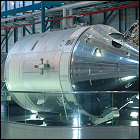 A thruster leak in the Skylab 3 crew’s Apollo command/service module forces NASA to consider a Skylab Rescue mission using a modified five-seater Apollo vehicle, mounted atop a Saturn IB and rolled out to the pad in readiness for the emergency flight. NASA brings in enough engineers and employees to have shifts working around the clock, seven days a week, to get the emergency mission ready for launch on September 9th. The thruster issue is later resolved, and the first-ever planned space rescue mission stands down. Astronauts Vance Brand and Don Lind are assigned to the rescue mission; both men later flew the Space Shuttle, though Brand will also fly in the Apollo-Soyuz Test Project. The modified command/service module and Saturn rocket are retained in case a rescue is needed for the final Skylab flight, and then as an Apollo-Soyuz backup vehicle, before being retired and displayed at the Smithsonian and Kennedy Space Center.
A thruster leak in the Skylab 3 crew’s Apollo command/service module forces NASA to consider a Skylab Rescue mission using a modified five-seater Apollo vehicle, mounted atop a Saturn IB and rolled out to the pad in readiness for the emergency flight. NASA brings in enough engineers and employees to have shifts working around the clock, seven days a week, to get the emergency mission ready for launch on September 9th. The thruster issue is later resolved, and the first-ever planned space rescue mission stands down. Astronauts Vance Brand and Don Lind are assigned to the rescue mission; both men later flew the Space Shuttle, though Brand will also fly in the Apollo-Soyuz Test Project. The modified command/service module and Saturn rocket are retained in case a rescue is needed for the final Skylab flight, and then as an Apollo-Soyuz backup vehicle, before being retired and displayed at the Smithsonian and Kennedy Space Center.
Skylab 3
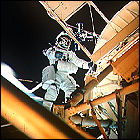 With the first Skylab crew having salvaged the first American space station, the second crew – designated Skylab 3 – lifts off for another long-term stay in space. Alan Bean, Jack Lousma and Owen Garriott spend 59 days aboard Skylab, performing a spacewalk to conduct further repairs to their damaged space station, investigating the effects of long-duration weightlessness and space travel on the human body, and observing the sun through Skylab’s solar telescope system. A thruster leak in the Apollo command/service module forces NASA to consider a rescue mission.
With the first Skylab crew having salvaged the first American space station, the second crew – designated Skylab 3 – lifts off for another long-term stay in space. Alan Bean, Jack Lousma and Owen Garriott spend 59 days aboard Skylab, performing a spacewalk to conduct further repairs to their damaged space station, investigating the effects of long-duration weightlessness and space travel on the human body, and observing the sun through Skylab’s solar telescope system. A thruster leak in the Apollo command/service module forces NASA to consider a rescue mission.
Skylab 2: mission accomplished
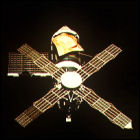 Having repaired and secured the damaged Skylab over the course of three spacewalks, the space station’s first three-man crew leaves the station and returns to Earth after 28 days in space, experiencing gravity after nearly a month of zero-G.
Having repaired and secured the damaged Skylab over the course of three spacewalks, the space station’s first three-man crew leaves the station and returns to Earth after 28 days in space, experiencing gravity after nearly a month of zero-G.
The first Skylab crew’s stay in space sets a new record, twice as long as the previous longest American manned spaceflight, Gemini 7 in 1965.
Skylab 2: save the station!
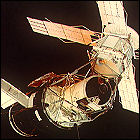 The first three-man Skylab crew lifts off to undertake a mission far different from the one for which they had trained. Their primary objective is now to save the crippled station from the damage it suffered during launch; as it is, Skylab is uninhabitable, with temperatures in its workshop and crew quarters soaring above 100 degrees, threatening to heat up items inside enough to fill the space with toxic gases. The first repair spacewalk takes place less than 24 hours after the crew arrives in an Apollo capsule, and succeeds in starting to drop the temperature inside.
The first three-man Skylab crew lifts off to undertake a mission far different from the one for which they had trained. Their primary objective is now to save the crippled station from the damage it suffered during launch; as it is, Skylab is uninhabitable, with temperatures in its workshop and crew quarters soaring above 100 degrees, threatening to heat up items inside enough to fill the space with toxic gases. The first repair spacewalk takes place less than 24 hours after the crew arrives in an Apollo capsule, and succeeds in starting to drop the temperature inside.
Apollo 17: the last man on the moon
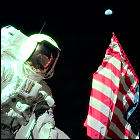 The final manned lunar landing mission lifts off atop a Saturn V rocket. Apollo 17 is the first mission to include a qualified geologist, Harrison Schmitt, in its crew; Gene Cernan and Schmitt descend to the surface aboard the lunar lander Challenger, where the last two men to walk on the moon spend a total of 22 hours exploring the Taurus-Littrow valley. For the third mission in a row, a lunar rover is stowed into one side of the lander. Astronaut Ron Evans orbits overhead in the command/service module America. The astronauts return on December 19th, bringing home nearly 250 pounds of lunar soil and rock samples.
The final manned lunar landing mission lifts off atop a Saturn V rocket. Apollo 17 is the first mission to include a qualified geologist, Harrison Schmitt, in its crew; Gene Cernan and Schmitt descend to the surface aboard the lunar lander Challenger, where the last two men to walk on the moon spend a total of 22 hours exploring the Taurus-Littrow valley. For the third mission in a row, a lunar rover is stowed into one side of the lander. Astronaut Ron Evans orbits overhead in the command/service module America. The astronauts return on December 19th, bringing home nearly 250 pounds of lunar soil and rock samples.
Apollo: the Shuttle’s lifeboat?
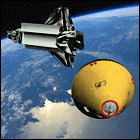 Space shuttle contractor North American Rockwell submits a safety study to NASA concerning safety and escape systems for the upcoming space shuttle, including a study of smaller vehicles with potential use as “lifeboats” in the event that a shuttle is unfit for return to Earth due to heat shield or other catastrophic damage. The various proposals, which include the possibility of permanently berthing an Apollo command module (another vehicle contracted to North American Rockwell) in the shuttle’s cargo bay for use as a lifeboat, are rejected by NASA due to the impact that each proposal would have on available space and weight for cargo.
Space shuttle contractor North American Rockwell submits a safety study to NASA concerning safety and escape systems for the upcoming space shuttle, including a study of smaller vehicles with potential use as “lifeboats” in the event that a shuttle is unfit for return to Earth due to heat shield or other catastrophic damage. The various proposals, which include the possibility of permanently berthing an Apollo command module (another vehicle contracted to North American Rockwell) in the shuttle’s cargo bay for use as a lifeboat, are rejected by NASA due to the impact that each proposal would have on available space and weight for cargo.
Apollo 16
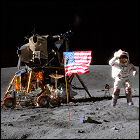 NASA launches the Apollo 16 mission to the moon, lasting 11 days total. Astronauts John Young and Charlie Duke descend to the lunar surface in the lander Orion, while Ken Mattingly pilots the command/service module Casper in orbit. Again, a lunar rover is tucked into one side of the lunar module, allowing Young and Duke to reach distances of 16 miles from their landing site. They spend a total of 20 hours walking on the moon’s surface, collecting over 200 pounds of soil and rock samples from the Descartes highlands region.
NASA launches the Apollo 16 mission to the moon, lasting 11 days total. Astronauts John Young and Charlie Duke descend to the lunar surface in the lander Orion, while Ken Mattingly pilots the command/service module Casper in orbit. Again, a lunar rover is tucked into one side of the lunar module, allowing Young and Duke to reach distances of 16 miles from their landing site. They spend a total of 20 hours walking on the moon’s surface, collecting over 200 pounds of soil and rock samples from the Descartes highlands region.
Apollo 15
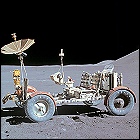 The Apollo 15 mission lifts off, carrying astronauts David Scott, James Irwin and Al Worden on a 12-day mission to the moon and back. Aboard the lunar module Falcon, Scott and Irwin become, respectively, the seventh and eighth men to walk on the moon, exploring the mountainous Hadley Rille region, while Worden pilots the command/service module Endeavour. The service module for this mission is equipped with a suite of sensors and instruments designed to be exposed to space in lunar orbit. Scott and Irwin become the first men to drive on the moon, covering over seven miles in the first lunar rover “moon buggy.”
The Apollo 15 mission lifts off, carrying astronauts David Scott, James Irwin and Al Worden on a 12-day mission to the moon and back. Aboard the lunar module Falcon, Scott and Irwin become, respectively, the seventh and eighth men to walk on the moon, exploring the mountainous Hadley Rille region, while Worden pilots the command/service module Endeavour. The service module for this mission is equipped with a suite of sensors and instruments designed to be exposed to space in lunar orbit. Scott and Irwin become the first men to drive on the moon, covering over seven miles in the first lunar rover “moon buggy.”
Apollo 14: back in business
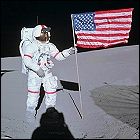 After nearly a year of examining the problems that nearly doomed the crew of Apollo 13, the third lunar landing is achieved by the crew of Apollo 14, commanded by Alan Shepard, the only one of the seven original Mercury astronauts to walk on the moon; lunar module pilot Edgar Mitchell joins him on the surface while Stu Roosa orbits in the command module Kitty Hawk. The Apollo 14 lunar module, Antares, makes the most accurate landing of the Apollo program in the Fra Mauro highlands (the landing site originally assigned to Apollo 13), where soil samples are collected, instruments are deployed, and Shepard becomes the first human being to hit a golf ball on the moon.
After nearly a year of examining the problems that nearly doomed the crew of Apollo 13, the third lunar landing is achieved by the crew of Apollo 14, commanded by Alan Shepard, the only one of the seven original Mercury astronauts to walk on the moon; lunar module pilot Edgar Mitchell joins him on the surface while Stu Roosa orbits in the command module Kitty Hawk. The Apollo 14 lunar module, Antares, makes the most accurate landing of the Apollo program in the Fra Mauro highlands (the landing site originally assigned to Apollo 13), where soil samples are collected, instruments are deployed, and Shepard becomes the first human being to hit a golf ball on the moon.
Apollo 18 & 19 cancelled
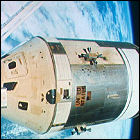 After the Congressional budget for the fiscal year of 1971 delivers a major blow to the budget for continued space exploration, NASA cancels Apollo 18 and 19, having already taken Apollo 20 off the schedule to use its Saturn V to launch a space station into Earth orbit. Both lunar landing missions are scrapped purely due to budgetary concerns, rather than to repurpose their hardware for other missions. The Saturn V rockets constructed to send these two missions to the moon become very large, expensive museum pieces. Barring any changes to crew rosters or destination, Apollo 18 would have taken Dick Gordon, Vance Brand and Harrison Schmitt to Copernicus crater, while Apollo 19 would have seen astronauts Fred Haise, William Pogue and Gerald Carr exploring the Hadley Rille, which became Apollo 15’s destination.
After the Congressional budget for the fiscal year of 1971 delivers a major blow to the budget for continued space exploration, NASA cancels Apollo 18 and 19, having already taken Apollo 20 off the schedule to use its Saturn V to launch a space station into Earth orbit. Both lunar landing missions are scrapped purely due to budgetary concerns, rather than to repurpose their hardware for other missions. The Saturn V rockets constructed to send these two missions to the moon become very large, expensive museum pieces. Barring any changes to crew rosters or destination, Apollo 18 would have taken Dick Gordon, Vance Brand and Harrison Schmitt to Copernicus crater, while Apollo 19 would have seen astronauts Fred Haise, William Pogue and Gerald Carr exploring the Hadley Rille, which became Apollo 15’s destination.
Apollo 13 returns home
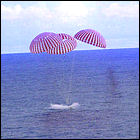 Having become the stuff of round-the-clock news coverage (though few media outlets bothered to cover any aspects of the mission before the emergency took place), the reactivated Apollo 13 command module Odyssey successfully reenters Earth’s atmosphere and returns its crew safely. (The lunar module, Aquarius, has been discarded in Earth orbit, where it eventually disintegrates, upon reentry; rather than landing on the moon, its fuel and air reserves have served the much more important function of keeping the crew alive.)
Having become the stuff of round-the-clock news coverage (though few media outlets bothered to cover any aspects of the mission before the emergency took place), the reactivated Apollo 13 command module Odyssey successfully reenters Earth’s atmosphere and returns its crew safely. (The lunar module, Aquarius, has been discarded in Earth orbit, where it eventually disintegrates, upon reentry; rather than landing on the moon, its fuel and air reserves have served the much more important function of keeping the crew alive.)
This mission is dramatized in both the We Interrupt This Mission episode of HBO’s 1998 series From The Earth To The Moon, as well as the 1995 movie Apollo 13.
Apollo 13: “Houston, we’ve had a problem”
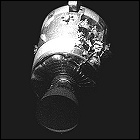 Halfway between Earth and the moon, a fuel cell rupture in the Apollo 13 service module causes a massive explosion. The crew has to activate the landing module, Aquarius, to use it as a “lifeboat”; the oxygen and power reserves of the command module, Odyssey, have been compromised by the explosion and must be preserved for re-entry. The crew endures extreme cold and must ration consumables to survive. Fortunately, there’s enough fuel in Aquarius’ descent stage to put the combined vehicle on a free-return trajectory, looping it around the far side of the moon for an immediate return to Earth.
Halfway between Earth and the moon, a fuel cell rupture in the Apollo 13 service module causes a massive explosion. The crew has to activate the landing module, Aquarius, to use it as a “lifeboat”; the oxygen and power reserves of the command module, Odyssey, have been compromised by the explosion and must be preserved for re-entry. The crew endures extreme cold and must ration consumables to survive. Fortunately, there’s enough fuel in Aquarius’ descent stage to put the combined vehicle on a free-return trajectory, looping it around the far side of the moon for an immediate return to Earth.
This mission is dramatized in both the We Interrupt This Mission episode of HBO’s 1998 series From The Earth To The Moon, as well as the 1995 movie Apollo 13.
Apollo 13
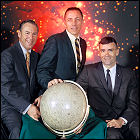 The third planned lunar landing mission, Apollo 13, lifts off. Astronauts Jim Lovell and Fred Haise are scheduled to walk in the Fra Mauro region of the moon. Command module pilot Ken Mattingly falls victim to a medical condition, leaving NASA to make a rare substitution, rotating the backup crew’s command module pilot, Jack Swigert, to the prime crew prior to launch.
The third planned lunar landing mission, Apollo 13, lifts off. Astronauts Jim Lovell and Fred Haise are scheduled to walk in the Fra Mauro region of the moon. Command module pilot Ken Mattingly falls victim to a medical condition, leaving NASA to make a rare substitution, rotating the backup crew’s command module pilot, Jack Swigert, to the prime crew prior to launch.
This mission is dramatized in both the We Interrupt This Mission episode of HBO’s 1998 series From The Earth To The Moon, as well as the 1995 movie Apollo 13.
Hear about it on the Sci-Fi 5 podcast